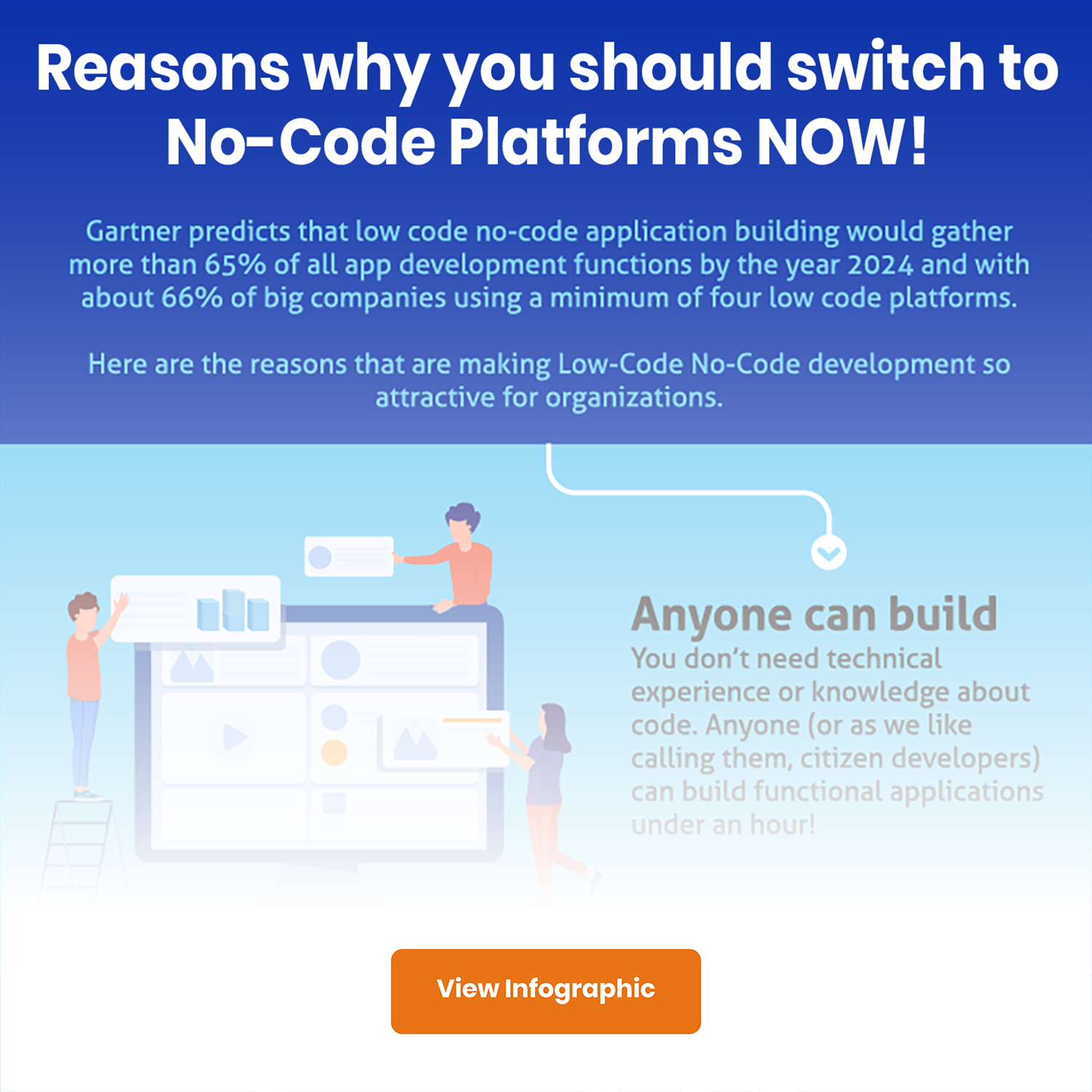
You must have heard of the latest buzz in the world of software development! No-code and low-code platforms are changing the game!
In recent years, we’ve witnessed a revolutionary shift in the world of software development with the emergence of low-code no-code development. These innovative approaches have transformed the way businesses create applications by eliminating the need for traditional coding skills. The demand for digital transformation is at an all-time high, and companies like yours are increasingly adopting no-code/low-code platforms to meet their software development needs. Just take a look at the numbers!
According to a report by Gartner, numerous businesses in the market are expected to utilize low code and no code development platforms to generate 70% of new applications by 2025. This will push the market value to an estimated $10 billion. And the growth doesn’t stop there! Gartner forecasts that the no-code/low-code platform market will reach an impressive $12.3 billion.
15 Reasons Why Companies are Switching to Low-Code No-Code Developments
Let’s explore 15 compelling reasons why companies are making the switch, backed by relevant statistics and credible sources.
1. Faster Development Cycles
Who doesn’t love speed? With no-code/low-code platforms, we can develop applications up to ten times faster compared to traditional coding methods. Imagine the time you’ll save!
But how is this possible?
No-code/low-code platforms provide a visual interface and pre-built modules that simplify development. You don’t have to write bulk lines of code from scratch. Instead, you can use intuitive drag-and-drop features and predefined components to build your application’s functionality. It’s like building with blocks, where you can quickly assemble the pieces and create something amazing. According to a report by Forrester, low-code development can deliver applications up to ten times faster than traditional coding methods. You can have a competitive edge in the market by embracing faster development cycles. You’ll be able to respond swiftly to changing customer demands, industry trends, and emerging opportunities. Speed is the virtue of the game, and no-code/low-code platforms give you the tools to win.
Also Read: Top 15 Benefits of No-Code App Development
2. Cost Savings
Let’s talk money. Traditional software development can be expensive, but no-code/low-code platforms significantly reduce development costs.
So, how do no-code/low-code platforms help you save money?
With no-code/low-code platforms, you can empower your existing team and even enable citizen developers—individuals within your organization with domain knowledge but limited coding expertise—to actively participate in the development process. This democratization of development not only saves costs but also fosters innovation within your own ranks.
These platforms offer a visual interface where you can drag and drop components, configure workflows, and easily create the desired functionality. You can reduce development time and costs by leveraging these pre-built resources while still delivering high-quality applications.
Also, no-code/low-code platforms enable rapid prototyping and iterative development. This means you can quickly gather feedback, make necessary improvements, and avoid costly rework in the later stages of development. By incorporating user feedback early on, you can ensure that your application meets customer expectations and market demands, minimizing the risk of costly revisions or failed projects.
As per Gartner, more than 65% of application development activity will be driven by low-code platforms. That’s a clear indication of the cost-saving potential. Imagine the impact on your budget when you can develop applications faster and more efficiently, all while reducing development costs.
3. Increased Efficiency
No-code/low-code platforms streamline development by offering pre-built modules and templates. Imagine the time & efforts you can save by utilizing these pre-built resources. Instead of starting from scratch and coding every aspect of your application, you can simply drag and drop the desired components, configure workflows, and customize them to fit your specific needs. It’s like building with building blocks rather than painstakingly crafting each piece from scratch.
And the best part? This streamlined approach translates into significant time savings. In a survey conducted by Forrester, it was found that organizations utilizing no-code/low-code platforms experienced an average of 45% reduction in development time compared to traditional coding methods. These significant time savings allows businesses to accelerate their application development processes and deliver solutions to the market faster.
4. Agile Adaptation
Change is inevitable, & your business needs to adapt quickly to keep up with market demands. With the ability to make rapid changes & updation to applications, introduce new features, and address customer needs in a timely manner, businesses using no-code/low-code platforms have a competitive edge in the market.
Gartner survey revealed that 75% of organizations that adopted low-code development enhanced their ability to quickly adapt to changing market demand. Stay ahead of the game!
Also Read: 10 Powerful Solutions you can build with No-Code Tools
5. Enhanced Collaboration
Collaboration makes dreams happen. No-code/low-code platforms bring together business stakeholders, developers, and IT teams, fostering collaboration like never before. They provide a visual interface that even non-technical folks can use to actively participate in the development process. Imagine the power of teamwork!
One of the key features that enable this collaboration is the visual interface. Instead of relying solely on lines of code, no-code/low-code platforms offer intuitive drag-and-drop interfaces, interactive workflows, and visual editors. This means that even non-technical individuals can actively participate in the development process. Just imagine the possibilities!
Business stakeholders can provide valuable insights and contribute to the design & functionality of the app without having to learn complex coding languages. They can visually define workflow, specify business rules, and contribute to the overall user experience. It’s a win-win situation where the expertise of both technical and non-technical individuals is leveraged to create exceptional applications.
Developers and IT teams, on the other hand, can collaborate more closely with business stakeholders. They can easily understand the requirements, iterate on feedback, and make necessary adjustments in real time. The visual interface allows for a more intuitive and efficient communication channel, reducing misunderstandings and ensuring that everyone is on the same page.
The power of teamwork truly shines with no-code/low-code platforms. This collaborative approach fosters a sense of ownership and collective responsibility, leading to better outcomes and higher-quality applications.
6. Empowering Citizen Developers
It’s time to unlock the hidden talents within your organization. No-code/low-code platforms empower citizen developers—individuals with domain knowledge but limited coding expertise. By enabling them to create applications, you can tap into the potential of your employees and foster innovation.

7. Greater Accessibility
One don’t have to be a coding genius to create applications anymore. No-code/low-code platforms make development accessible to a broader range of individuals. Even those with limited technical skills can actively contribute.
Over 50% of medium to large enterprises are expected to have adopted a no-code/low-code platform, as predicted by Gartner. Let’s empower everyone!
8. Improved Time-to-Market
In today’s competitive business landscape, speed is of the essence. And when it comes to application development, time-to-market can make all the difference. This is where no-code/low-code platforms truly shine, enabling businesses to accelerate their development cycles and stay ahead of the competition.
Developing and launching an application with traditional coding methods can be time-consuming. However, with no-code/low-code platforms, the game changes entirely. These platforms empower developers to work more efficiently and effectively, resulting in significantly reduced time-to-market.
According to a study by Forrester, low-code development can cut the average time-to-market by 30-40%. Just think about the advantage this gives you over your competitors. With faster development cycles, you can quickly transform your ideas into fully functional applications and bring them to market at a rapid pace.
Also Read: Top No-Code App Builders
9. Streamlined Maintenance
Maintenance headaches be gone! Traditional code-based applications often require extensive upkeep, but no-code/low-code platforms simplify maintenance tasks.
With centralized control and visual interfaces, companies using low-code platforms have reported a 70% reduction in maintenance efforts. Peace of mind and fewer late-night debugging sessions!
10. Scalability
Scalability is a critical factor in today’s digital landscape. As your user base expands, your applications need to accommodate the increased traffic, data, and functionality. This is where no-code/low-code platforms truly shine, providing you with the tools & capabilities to scale your applications seamlessly.
According to Gartner, an impressive 65% of development activity will be supported by low-code platforms. This statistic speaks volumes about the scalability potential of these solutions. It’s not just a vague passing trend; it’s a transformation in the way businesses approach application development and growth.
11. Risk Mitigation
We all want to minimize risks, right? No-code/low-code platforms provide a controlled and governed development environment, reducing the risk of errors and security vulnerabilities.
According to Forrester’s report, organizations that embraced low-code development experienced a significant reduction in risk. They found that low-code platforms reduced the probability of major application security breaches by 50%. This statistic highlights the effectiveness of no-code/low-code platforms in mitigating risks associated with traditional software development methods. Stay secure and worry-free!
12. Improved User Experience
Happy users mean a successful business, and with no-code/low-code platforms, you have the power to create applications that prioritize user experience. It’s all about making your users’ lives easier and more enjoyable. Users have high expectations regarding the applications they interact with, and they want seamless navigation, intuitive interfaces, and efficient workflows. No-code/low-code platforms recognize this need and provide you with the tools to create applications that meet and exceed user expectations.
Imagine building an application that users love from the moment they interact with it. With no-code/low-code platforms, this becomes a reality. These platforms offer a range of user-centric features and capabilities that enable you to design intuitive and user-friendly interfaces.
According to Forrester, organizations using low-code platforms achieved an average 50% improvement in customer experience. That’s a significant boost that can lead to increased customer satisfaction, loyalty, and ultimately, business success.
13. Integration Capabilities
Connectivity is the key to exhausting the full potential of your applications, and with no-code/low-code platforms, you have the power to seamlessly connect your applications with existing systems and databases.
Whether you need to integrate with customer relationship management (CRM) systems, enterprise resource planning (ERP) solutions, or any other third-party services, no-code/low-code platforms have got you covered. These platforms offer a range of integration options and APIs that make it easier than ever to establish connections and exchange data.
Also Read: How to effectively choose and adopt a No-Code Platform
14. Rapid Prototyping and Iteration
Testing ideas and gathering feedback is crucial. No-code/low-code platforms facilitate rapid prototyping and iterative development, allowing businesses to refine their applications early in the process.
Gartner’s study found that 75% of surveyed organizations used low-code platforms for rapid prototyping and iterative development. Innovate and iterate like a pro!

15. Improved Compliance and Governance
No-code/low-code platforms offer enhanced compliance and governance capabilities, ensuring that applications meet regulatory requirements and adhere to organizational policies. These platforms provide built-in security features, data encryption, and access controls, reducing the risk of data breaches and unauthorized access. With the ability to enforce compliance standards and track changes within the development process, companies can maintain high data security & integrity.
No-code/low-code platforms empower organizations to develop applications that meet industry-specific regulations and compliance standards, fostering trust among customers and stakeholders.
Conclusion
You’ve just discovered the game-changing reasons why companies are switching to no-code/low-code platforms. The benefits are undeniable, from faster development cycles and cost savings to increased efficiency and improved collaboration. These platforms bridge the skills gap, enhance accessibility, offer scalability, and mitigate risks while delivering exceptional user experiences. As businesses prioritize digital transformation, the adoption of no-code/low-code platforms is set to revolutionize the software development landscape.
Now that you’re armed with this knowledge, it’s the right time to ask yourself: If you are ready to join the no-code/low-code revolution? Imagine the possibilities when you can develop applications faster, save costs, and work more efficiently. Picture the seamless collaboration among your teams, from business stakeholders to developers and IT experts. Envision the scalability and adaptability of your applications as you meet growing user demands. Consider the risk mitigation and improved user experiences that await you.
Embracing no-code/low-code platforms is like unlocking a world of innovation and efficiency. It’s an opportunity to empower your teams, leverage their expertise, and bring your ideas to life without the constraints of traditional coding. The best part? You don’t have to be a coding ninja to thrive in this revolution. With intuitive interfaces and user-friendly tools, you can dive right in and start building remarkable applications.
So, are you ready to join the no-code/low-code revolution?
Experience the joy of coding without coding! Get started with our platform, and experience the ease of automated processes and personalized app building.
Frequently Asked Questions(FAQs)
Q. Why the surge in No-Code and Low-Code adoption?
Companies are adopting No-Code and Low-Code platforms due to their ability to accelerate software development, reduce costs, and empower non-developers to create applications, fostering innovation and efficiency.
Q. What are the Benefits of No-Code/Low-Code for businesses?
No-Code and Low-Code platforms offer reduced development time, cost savings, increased agility, and enhanced collaboration between IT and non-technical teams, driving overall productivity and competitiveness.
Q. How do these platforms speed up app development?
No-Code and Low-Code tools simplify the development process by offering pre-built templates, drag-and-drop interfaces, and automation, enabling even non-developers to create applications quickly.
Q. Which industries favor No-Code/Low-Code?
Industries like finance, healthcare, and manufacturing are increasingly adopting No-Code and Low-Code custom solutions for their agility, cost-effectiveness, and rapid response to market demands.
Q. What are the Challenges in transitioning to No-Code/Low-Code?
Challenges include security and compliance concerns, integration with existing systems, and the need for user training. Companies must address these issues to leverage No-Code and Low-Code benefits fully.
Subscribe
Login
Please login to comment
0 Comments
Oldest















